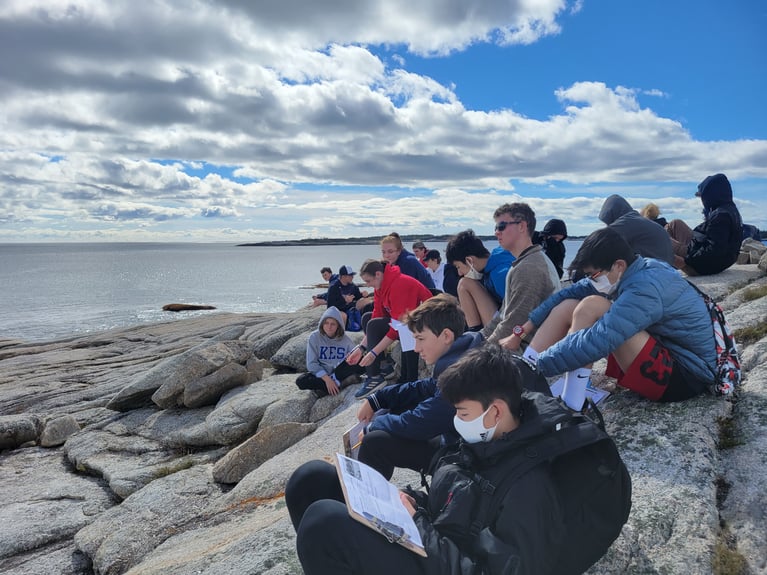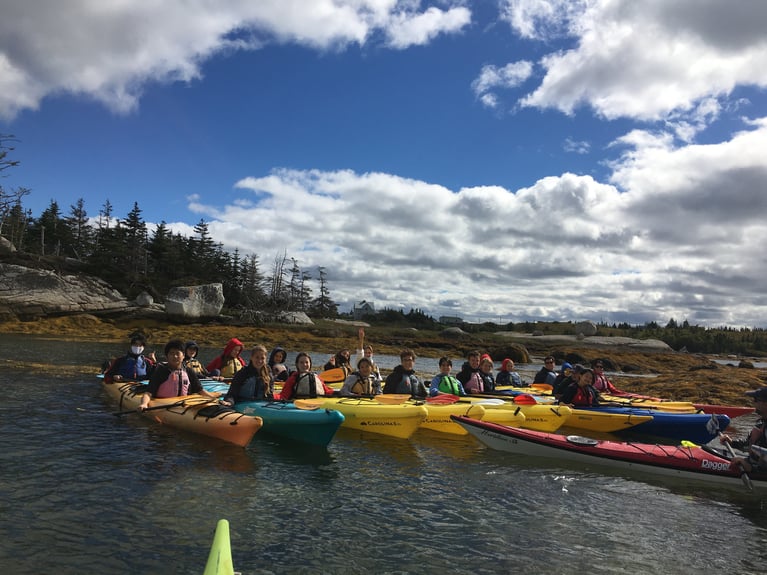
On Monday, October 4, Ms. Keoughan and Mr. Dietrich's oceans students travelled to Terrence Bay, NS, for a fun-filled day of hands-on learning in nature. With nearly 40 students in attendance, the group was split in two, with one group taking to the ocean while the other hiked the coastline.
The hike, led by Adam Zita of East Coast Outfitters, took students around the rugged shore and out to the Terrence Bay lighthouse – a community fixture since 1903. On the hike, Adam shared his knowledge of various flora and fauna (plant and animal life) native to the area, including juniper, bayberry, krummholz and lichen.
Students also learned about glacial erratics, which are glacially deposited rocks differing in size and type of rock native to the area in which they rest. Such rocks have travelled great distances, often hundreds to thousands of kilometres from their place of origin.
After a bagged lunch provided by our School kitchen staff, students switched spots and geared up to go kayaking. What started out as a cool and cloudy afternoon quickly gave way to sunny skies and warmer weather.
After a brief rundown on how to properly wear a life jacket, paddling for maximum efficiency, and a few other safety protocols, students took to the water. The laughter ensued as everyone got a feel for the nimble and tippy boats, but the learning curve was brief. After a few short minutes everyone was paddling with confidence and a clear sense of purpose.
The first stop on the kayak tour was a raft up, where everyone bunched their boats together, creating a giant flotilla of sorts. After a few photos and a brief history on the area, the group continued paddling to their next destination where they learned all about currents and tidal waters. An interesting comparison was the difference in tidal heights between the Atlantic coast and the Bay of Fundy, with tides ranging from five to six feet on the Atlantic coast, and anywhere from 20-30 feet in the Bay of Fundy. It was amazing to learn that such a difference existed in a province as small as Nova Scotia.

The next stop brought the group to Rogue's Roost Wilderness Area, where students learned all about crown land, protected land, and various aspects of conservation and how to ensure the preservation of natural resources. Finally, students were taught about the Coriolis effect, a phenomenon whereby a mass moving in a rotating system experiences a force, acting perpendicular to the direction of motion and to the axis of rotation. In simpler terms, and using the earth as an example, the effect tends to deflect moving objects to the right in the northern hemisphere, and to the left in the southern, and plays a major role in the formation of cyclonic weather systems.
From there, students headed back to land and disembarked their vessels. After all that time in the sun soaking up information, it was evident that everyone had their fill for the day on the quiet bus-ride back to school.
